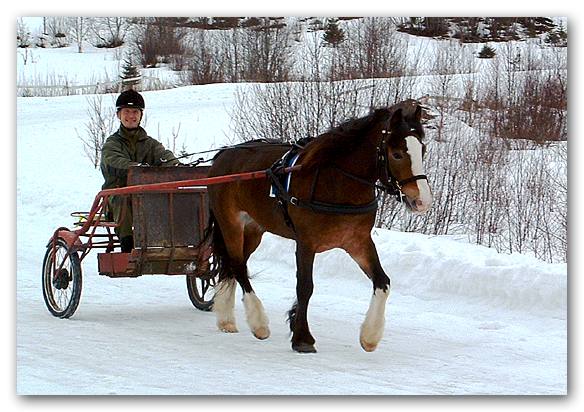Norwegian Coldblood
 The
great driver, Ulf Thoresen, with the wonderful coldblood Alm Svarten
The
great driver, Ulf Thoresen, with the wonderful coldblood Alm Svarten
The team amaze the public at Solvalla during the Elitlopp Day in May 1986:
New World Record for coldbloods with 1.21,5KR (2:11.1f).
Alm Svarten (f.1981) 6,1.21,5KR / 9.505.912 NOK (apr. USD 1,284,583)
388 starts - 184 wins, 47 second, 29 third.
The coldblooded trotter is bred from the Norwegian light draft horse, the Dole
Horse. The Dole Horse is the largest of the Norwegian native horse breeds
Veikle Balder (1849 - 1873)
is the foundation sire of the Dole horse and the coldblood trotter. Veikle
Balder was mostly a Dole horse, but his grandsire was the English thoroughbred
Odin (by Partisan). Until the 1870s, Norwegian farmers only bred the Dole
horse. The Dole horse was known for their good temper, willingness to work
hard, and being inexpensive to maintain. They were very useful family horses,
getting lumber out of the woods, carving fields to make oats and getting
hay from the fields, etc.
From 1872, the Dole horse was bred in two different manners. The better gaited
trotters with speed were bred to be racehorses. These horses had a more natural
trot and competed in races on the icy lakes of Norway. This was the origin
of the coldblood trotter.
However, many farmers still needed the Dole horse to help with farm chores.
Today, the Dole horse and the coldblood belong to the same horse register,
but few people mix the two breeds. The breeders of racehorses (coldbloods)
do not want to breed to work horses (the Dole horse). Conversely, the breeders
of the Dole horse want more of a farm horse than a racehorse.
The coldblooded trotter is bred from the Norwegian light draft horse, the Dole Horse. The Dole Horse is the largest of the Norwegian native horse breeds
Veikle Balder (1849 - 1873)
is the foundation sire of the Dole horse and the coldblood trotter. Veikle Balder was mostly a Dole horse, but his grandsire was the English thoroughbred Odin (by Partisan). Until the 1870s, Norwegian farmers only bred the Dole horse. The Dole horse was known for their good temper, willingness to work hard, and being inexpensive to maintain. They were very useful family horses, getting lumber out of the woods, carving fields to make oats and getting hay from the fields, etc.
From 1872, the Dole horse was bred in two different manners. The better gaited trotters with speed were bred to be racehorses. These horses had a more natural trot and competed in races on the icy lakes of Norway. This was the origin of the coldblood trotter.
However, many farmers still needed the Dole horse to help with farm chores. Today, the Dole horse and the coldblood belong to the same horse register, but few people mix the two breeds. The breeders of racehorses (coldbloods) do not want to breed to work horses (the Dole horse). Conversely, the breeders of the Dole horse want more of a farm horse than a racehorse.
1
Association
.
Links
http://www.worldoftrotters.com/eng-kaldblods.htm
 The
great driver, Ulf Thoresen, with the wonderful coldblood Alm Svarten
The
great driver, Ulf Thoresen, with the wonderful coldblood Alm Svarten